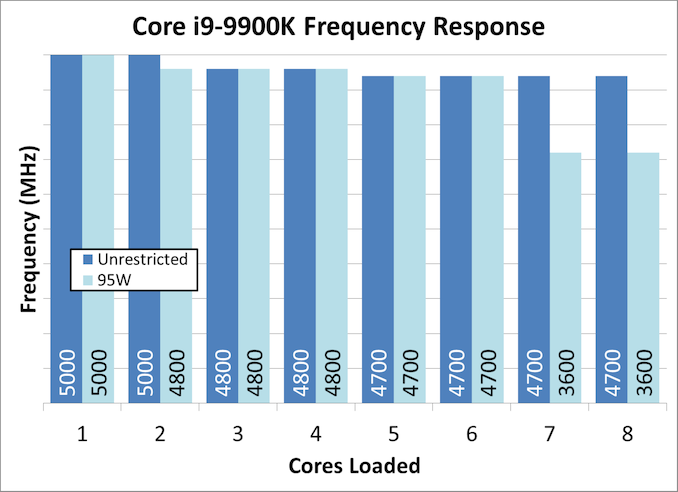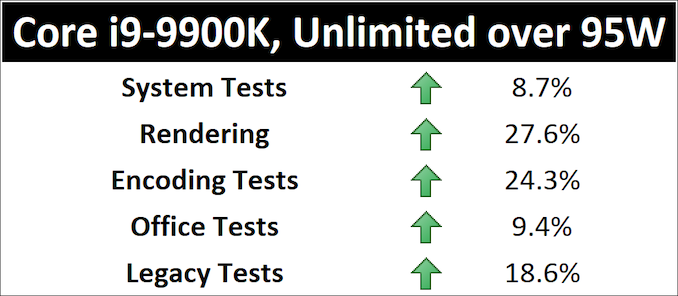The Intel Core i9-9900K at 95W: Fixing The Power for SFF
by Ian Cutress on November 29, 2018 8:00 AM ESTCore i9-9900K in Small Form Factors
Even with all the hullabaloo surrounding how Intel defines TDP and what values the company should actually be advertising for the power consumption of its processors, the simple fact is that processors generate thermal energy when they run. Sometimes it’s a small amount, and sometimes it’s a lot, but in every case that thermal energy has to be managed, either by the box cooler, some super extreme water chiller loop, or by a super massive fanless heatsink. In order to maintain performance, the thermal solution also has to be suitable for the environment at hand.
Nothing proves more channeling than designing a system for something small, and still maintaining high levels of performance. There are tradeoffs – performance for noise, or silence for performance. One way to manage this is through configuring the turbo and power values of the system in the firmware, and it is this method that OEMs use for laptops and mini-PCs.
Some Performance Loss, But More Efficient
The performance that Intel guarantees is the one on the box: the base frequency at the sustained TDP. For system integrators or builders, this gives a simple comparison point, and when we set our power consumption limits for the Core i9-9900K, this is what we saw at full load: 95W gave 3.6 GHz at 7-8 core load.
Losing almost half the power from standard operation caused the frequency to drop by 23% at the fast and furious end, which has a knock-on effect on performance. As was perhaps to be expected, for our throughput benchmarks, it was sizeable. For this data, we’re going to represent the performance uplift from 95W to the ‘unlimited power’ mode:
The system and office tests, which are a mix of latency and throughput tests, saw just under a 10% gain going from 95W to unlimited mode. For pure throughput however, that 23-24% difference in frequency gave an equivalent gain to the unlimited power mode. The only flipside is power: the extra performance pushes power consumption to 164-165W, which is a 74% power gain. If we were going for performance per watt, then the 95W wins that battle very easily. It all depends if the form factor the processor is in can provide sufficient cooling.
Doing these numbers gave me an idea for a metric for power efficiency. We currently run our power tests during a run of POV-Ray, and as a result, we can plot the power consumption during our POV-Ray test against the POV-Ray result score.
The highest performers are at the low end of the spectrum of what we’ve tested, with the Ryzen 5 2400G and Core i5-8305G (Kaby Lake-G) being the top performers, getting an efficiency rating (score/power) of 67 and 53 respectively. However Intel’s Skylake-X parts and the Threadripper 2990WX all scored highly on this metric too, around the 43 mark. This is likely because these high-power processors actually give less power per core, and each core is nearer to its peak efficiency for frequency/voltage.
The Intel Core i9-9900K, in normal operation, scores an efficiency rating of 32.9. This rises to 44.2 if the processor is fixed to 95W. This ultimately puts the 9900K in the limelight for an SFF system: when the power is limited to 95W, you get all the single core performance, most of the variable threaded performance, and around a 10-27% loss in throughput testing, most noticably in rendering. Overall, it acts like a 9900K in single thread mode, and like a 9700K in multi-thread mode.














101 Comments
View All Comments
edzieba - Thursday, November 29, 2018 - link
The difference is the ARM chips being labelled with the short-term term frequencies and performance, while Intel put the steady state values on the box. Motherboard manufacturers throw the box values right out the window, but if Intel were to dictate /those/ the wailing and gnashing of teeth from the peanut gallery would be cacaphonous.melgross - Thursday, November 29, 2018 - link
Its just a matter of semantics. It doesn’t have to be spelled out.Targon - Thursday, November 29, 2018 - link
There are actually three primary states. Base clocks, boost or turbo speeds, and then you can get thermal throttle which will actually lower the speed below the base clock speed. If the i9-9900k has a base of 3.6GHz, a turbo that goes up to 5GHz, but you have poor cooling, you may be seeing the CPU sticking to that 3.6GHz, or even below it if the temperatures get too high.This is where those very thin laptops may have Ryzen versions performing better than Intel, because of the temperatures keeping the chip running at or even below base speeds. For a small form factor machine, will the 9900k be running at base speeds ALL THE TIME due to temperatures/TDP/cooling? In the same small form factor case, would a Ryzen 7 2700X end up having a similar level of performance after several hours(to allow the heat generation to stabilize)? If you start when things are COLD, you could turn the machine on and run benchmarks, and see better numbers than if the machine were already on and you had been running intensive applications for several hours prior to running the benchmarks.
eastcoast_pete - Thursday, November 29, 2018 - link
@Ian: Thanks for this informative test and review. One comment, one question/request. Comment: I continue to be struck by Intel's prowess when AVX512/AVX2 comes into play. I am also (negatively) impressed by the thermal load use of these instructions causes. The reduction in performance when using AVX512/AVX2 under strict adherence to a TdP of 95 Wh speaks volumes. Did you ever have a chance to ask Intel why running AVX makes their chips so power-hungry? Even if not, I'd appreciate your thoughts on why AVX makes Intel's chips run so hot.Here my question/request: I now that you/Anandtech have a large dataset on x264 video encoding speeds. However, especially for i7s and AMD's six-core and up Zen chips, I'd like to know how they fare when encoding/transcoding a 2160p 10bit video, as that is now in increasing demand, and really makes the processor sweat (and slow down, a lot). Any chance you and your colleagues can add that to the encoding tests? If space is an issue, I suggest to dump the x264 720p speed test; even a lowly Athlon or Celeron chip does that quite well, and at good speed.
HStewart - Thursday, November 29, 2018 - link
I believe you can turn off AVX512 in bios - it use in special application that need the speedAlso I would think the external GPU's is another major factor in considering power requirements on a system.
I don't belkieve there is any power needs or reduction in topp speed for AVX2 only that AVX512 uses extra power on system and top frequency are reduce if being used.
One thing about AVX2 - on Intel it is 256bit and AMD has dual 128 bits currently - not sure about new Zen's coming out next year. But at least with PowerDirector, it give you significantly performance increase
GreenReaper - Saturday, December 1, 2018 - link
It's pretty simple, really: the more data the CPU has to process in parallel, the more horsepower it uses. It's like doubling or quadrupling the number of active cylinders in an engine - you gain performance, but it requires more power and produces more heat. That's why they're off if not in use.Dedicated GPU blocks for video coding will also use more power, but are likely to be far more efficient than doing the operations with general code - as long as it's within their defined capabilities. (Similarly, if you had to do the equivalent of the AVX operations without the relevant hardware, it would probably use even more power than it currently does, at least over the extra time it took.)
Davenreturns - Thursday, November 29, 2018 - link
I have found much confusion among the readers on hardware review websites when it comes to this issue. So I would like to present some information from Anandtech's Bench tool in order to clarify the situation for me and others hopefully:Looking at the CPU Power Bench
https://www.anandtech.com/bench/CPU-2019/2194
The following two processors have these results under full package, full load:
i7-6700k 82.55W First mainstream desktop 14 nm processor, 95W TDP according to Intel
i9-9900k 168.48W Latest mainstream desktop 14 nm processor, 95W TDP according to Intel
I assume that these two values were measured in unlimited mode. If this is the case, this means that the power listed above is when all cores/threads are loaded at full max turbo mode. So if you are expecting a certain level of performance given that Intel advertises 95W for both CPUs, then you are being misled and may not get the performance you are expecting when upgrading the CPU but not your cooling.
This is a CHANGE from the past in how Intel uses TDP without telling the customer. It also highlights that Intel use to be conservative with cores/clocks/turbo when they had no competition and were able to shrink nodes between Nehalem and Skylake. Now they are PRETENDING that they can just double the cores and raise clocks on the same node and not increase power. Please correct me if I'm wrong, but it doesn't look like this is the case anymore.
AlyxSharkBite - Thursday, November 29, 2018 - link
Really interesting how when you limit it to 95W it’s really close to the 2700X4800z - Thursday, November 29, 2018 - link
A power unlimited 2700x. Also this article doesn't include any games. If it did you'd see the 9900k still does much better, because games don't use all 8 cores.schujj07 - Thursday, November 29, 2018 - link
2700X - 117.18W Max = 11.6% over stated TDP9900K - 168.48W Nax = 77.3% over stated TDP
Don't forget not everyone views gaming and the end all be all form of benchmarking. Would it be interesting to see if it affects the gaming sure. It most certainly would affect those who game and stream at the same time.